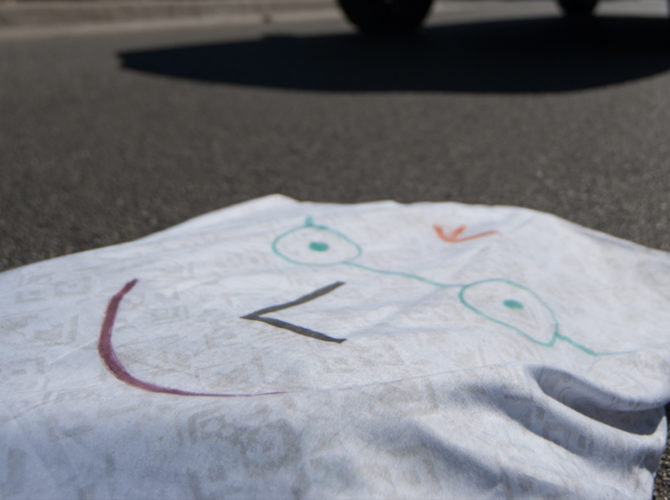Story by Amanda Cordero | Photo by Trey Honeycutt
At 5 feet 5 inches and barely 100 pounds, Cameron Wiles is a wisp of a girl, so it is almost comical when she jumps into her white Toyota Highlander with a 20-pound bag of rice and a nervous but determined expression on her face. Almost comical. She has drawn a goofy smile on the bag and has named it Spud. It’s cute, but it’s not about cute for Wiles. She has plans to destroy Spud.
Three friends are with Wiles on this day of destruction. She wears a shirt with the words “Chill and Recognize” emblazoned on the front. Chill and Recognize. Chill and Recognize. Chill and Recognize. It’s a mantra. She wants to let the world – and herself – know that she is on a mission to defeat this bag of rice, to defeat her fears.
And so she tries. They drive to Cameron Park and find a secluded stretch of parking lot. Spud is placed down on the ground and over and over and over again, Wiles tries to run him over with her car. She misses here and there, but she also manages to run over Spud a few times. A half hour later, she throws Spud in the back of her car, his goofy smile now covered with tire marks. Wiles laughs.
“Well, that was disappointing,” she says. She drives back, slowly, carefully. She is still scared. She is still anxious.
This, for Wiles, is her therapy session for the day. This is how she helps herself cope as she lives with anxiety and obsessive compulsive disorder, which includes a constant fear of hitting somebody with her car. According to BeyondOCD, this form of cognitive behavioral therapy, called Exposure Response Prevention, helps patients decrease their anxiety through therapeutic exposures, such as these Cameron Park trips.
This episode is just one of many in which Wiles has had to confront the reality of her anxiety. She started noticing symptoms of anxiety in high school.
“Five years ago, I just started getting nervous going to school,” Wiles said. “I just had this idea that other people were going to cheat off me or that I was going to cheat off other people – which I would never do. Those thoughts would bother me so much that I would not focus on the actual test material, and in turn, I didn’t do so well.”
Her anxiety touched other aspects of her life in a more serious way, though, especially when it came to driving.
“Driving is the biggest trigger for my anxiety,” she said. “I don’t want anything to happen that is my fault. It’s more like ‘What if I do something and I don’t know it?’ I really, really don’t want to hit anyone.”
Wiles recognized that she needed to learn how to handle her anxiety, especially with the reality of college looming closer. The summer before her senior year, Wiles visited Chicago for a month. That’s when, and where, things shifted for her.
“I ended up talking to my aunt about everything. And she said, ‘If you don’t tell your parents, I’m going to,’” Wiles said. “She ultimately realized how big of a problem it was, and she was the extra boost I needed to tell my mom.”
Two weeks after she returned from her Chicago trip, Wiles’ parents found her a psychologist. Wiles and her parents didn’t recognize the full extent of her anxiety; for them, this was just how she was wired.
“My psychologist said, ‘Look, you have pretty severe anxiety,’” she said. “And then there was the OCD – that was surprising.”
While Wiles understood she was struggling with anxious thoughts and feelings, the diagnosis was something she hadn’t considered.
“OCD goes hand-in-hand with anxiety,” she said. “If you have anxiety, you don’t necessarily have OCD, but if you have OCD, you have anxiety.”
Armed with her official diagnosis and its complications, Wiles found relief and comfort.
“Once I had a label for it, it was a huge weight off my chest,” she said. “I was like, ‘Oh, other people have this too.’ So I started doing research.”
Wiles immersed herself in learning more about her mental health. She read books, watched movies and talked to people. She went through ERP.
“What [ERP] does is it exposes you to your fears, your worries, and your obsessions,” she said. “For example, if you have a fear of leaving the stove turned on, you tell yourself that you can only check it once and not any more than that. With ERP, you take baby steps.”
Wiles’ has indeed taken baby steps. Despite her anxiety, she graduated from high school at the top of her class, but coming to Baylor posed its own challenges and required its own new baby steps.
“Cameron showed up the first day of Line Camp in tears,” said Ryan McNamara, Wiles’ Honors Line Camp leader. “But then she ended the week on a real high note and in a place of confidence. Out of all my campers, she had the most growth from this experience.”
While Line Camp helped set Wiles up for Baylor, there are still challenges she and other students with anxiety face every day. She lives in the Honors Residential College, where anxiety seems to run rampant among its residents.
“I see anxiety everywhere in this community,” Kaleb Loomis, chaplain for the HRC, said. “Sometimes it’s a student who is freaking out because he just got his first B on an essay or a sophomore who is really worried about getting a job after college.”
This anxiety isn’t just reserved for the HRC, however. It is an epidemic among college students everywhere. According to the American Psychological Association, anxiety is the top mental health issue among college students, with 41.6 percent of students having experienced it.
“I think we ask students to do more now than we asked students to do 50 years ago,” Loomis said. “There’s this pressure of doing well in college, having a career after college, paying for college itself. And for many people, their world is turned upside down.”
The world may be turned upside down for many students, but there are ways to help right it again.
“Learning when to notice your anxiety is happening is the first step,” Loomis said. “And that comes through reflection and awareness and talking to people about it, whether that’s using a counseling center or meeting with a chaplain.”
Students can help others by shifting the paradigm of anxiety.
“Break down the stigma of mental health by being vulnerable with other people,” Loomis said. “Whether you have a serious mental health issue or not, or you have a sibling that does, talk to each other. That goes a long way.”
Through this vulnerability, anxiety becomes less of a seemingly isolated problem.
“It’s easy to think that you’re the only one affected by anxiety, but that isn’t true,” Wiles said. “It’s nice knowing that I’m not the only one.”
Similarly, students helping their friends with their mental health should recognize that they are not the only ones who can help.
“I can walk alongside people every day,” Loomis said. “But when the situation is too severe, I can still walk with people, but I cannot be their primary source of care.”
Loomis suggests empathetic listening as a tool to help those with anxiety, to help get to the root of the issue.
“Sometimes, anxiety isn’t a choice,” Loomis said. “Students can help each other by understanding it isn’t a choice and being willing to go along with what works best with that person.”
Wiles understands this concept firsthand. Despite the pressures of living in a community as dynamic as the HRC, she finds that the community is incredibly supportive for her needs.
“I’m pretty good at keeping myself accountable and I need that,” Wiles said. “I told my friends that if I ask questions because I’m anxious, they have to be mean to me. They make me accountable to myself. It has to be on me.”
Wiles is doing her part to tackle not only her anxiety, but to help others learn to cope with their struggles as well. During her freshman year, Wiles and Loomis hosted an event in the HRC where they talked about mental health realities for college students. It was a powerful experience for her to see so many people come with their own set of trials and tribulations. Moments like this help Wiles lean into community and friendship to help mitigate her anxiety.
“Let your friends with anxiety know that you’re there and that you want to help,” Wiles said. “The most important thing is just being there for somebody. Let them know they’re not alone.”
That’s why, on an overcast day in early October, Cameron and her friends pile into the car and drive to Cameron Park. Her three friends cheer her on as she drives over Spud multiple times, all of them screaming.
This is ERP at its finest, at its weirdest. She wants to know what it’s like to hit a body, or something like that – they don’t really understand exactly what Wiles is thinking. They don’t understand, but that’s okay. They just know that she needs to confront her biggest trigger. And so here they are. She is Cameron Wiles and she has anxiety. They are Cameron’s friends and they are ready to Chill and Recognize.
She revs the cars again. She’s going for it.

